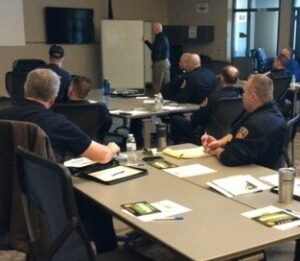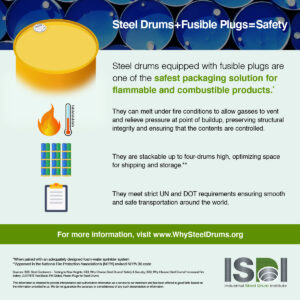The following article was published in TRANSCAER’s 2020-2021 Magazine. A PDF version of this article can be viewed and downloaded, here.
 As a proud sponsor of TRANSCAER℠, the Industrial Steel Drum Institute (ISDI) routinely conducts trainings for first responders looking to learn more about the proper use of steel drums and how to respond to a potentially hazardous situation. These are valid concerns since steel drums are widely used to transport more than 50 million tons of both hazardous and nonhazardous materials around the world each year.
As a proud sponsor of TRANSCAER℠, the Industrial Steel Drum Institute (ISDI) routinely conducts trainings for first responders looking to learn more about the proper use of steel drums and how to respond to a potentially hazardous situation. These are valid concerns since steel drums are widely used to transport more than 50 million tons of both hazardous and nonhazardous materials around the world each year.
“ISDI gladly helps first responders learn how to safely handle steel drums,” said Susan Nauman, executive director of the Industrial Steel Drum Institute. “Through both our live and virtual trainings, we’re able to share a lot of critical information – from the unique components of steel drums, to the different types of drums and their safety advantages to the typical transportation practices.”
Following the trainings, attendees are encouraged to ask the ISDI trainers questions or clarifications; the most common questions received concern damage to drums and proper use of fusible plugs with ignitable liquids. Here are the top three questions and answers:
1) Can you advise how many fusible plugs are required for 55-gallon steel drums to be considered “relieving style?”
Paragraph 16.5.1.7 in NFPA 30 states “When relieving-style containers are used, both 3 ⁄4 in. (20 mm) and 2 in. (50 mm) listed and labeled pressure relieving mechanisms are required on containers greater than 6 gal. (23 L) capacity.”
Furthermore, when fusible (plastic) plugs are used with 55 gal. steel drums, they “shall be listed and labeled in accordance with FM Global Approval Standard for Plastic Plugs for Steel Drums, Class Number 6083, or equivalent,” per paragraph 16.3.6 in NFPA 30.
2) Where can I obtain a copy of NFPA Code 30?
NFPA30 may be accessed for free at www.nfpa.org/codes-and-standards/document-information-pages?- mode=code&code=30. You will be asked to create a free profile to access the document in read-only format. To do so, visit www.nfpa.org/Login.
3) If increasing thickness prevents denting of steel drums and rolling hoops aid in vacuum resistance, what feature can prevent distortion due to internal pressure build-up?
Increasing steel thickness can help prevent distortion. However, if the internal pressure buildup is so high the drum distorts, a vent should be considered. Vents can be used if they do not create a hazardous environment during transportation due to the release of the contents. The same vendors that manufacture steel and fusible plugs can provide vented plugs.
ISDI has compiled additional frequently asked questions (FAQs) on their website in an effort to help users better understand the many aspects and use of steel drums.
First responders interested in learning more can attend one of ISDI’s scheduled live trainings, which are listed on the TRANSCAER website or can complete the ISDI course through TRANSCAER’s new Learning Management System (LMS) which launched in December 2020. For the live trainings and the LMS course, attendees will receive a training certificate upon completion.
If you have additional questions be sure to visit the ISDI website, whysteeldrums.org



